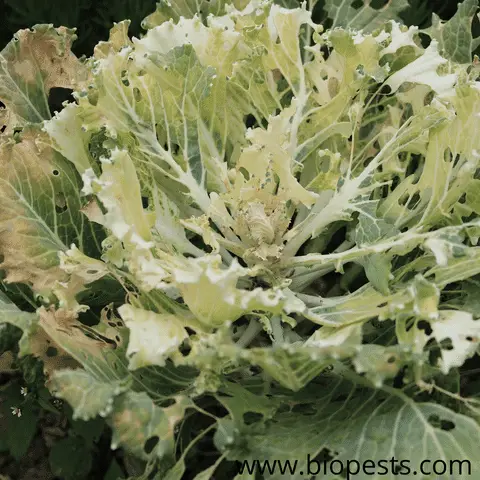If you are a gardener and a brassica lover (cabbages, broccoli, kale, etc), you surely know that your efforts in growing a nice, healthy, and robust cabbage could vanish in no time due to a sneaky enemy hidden among its leaves: the cabbage worm.
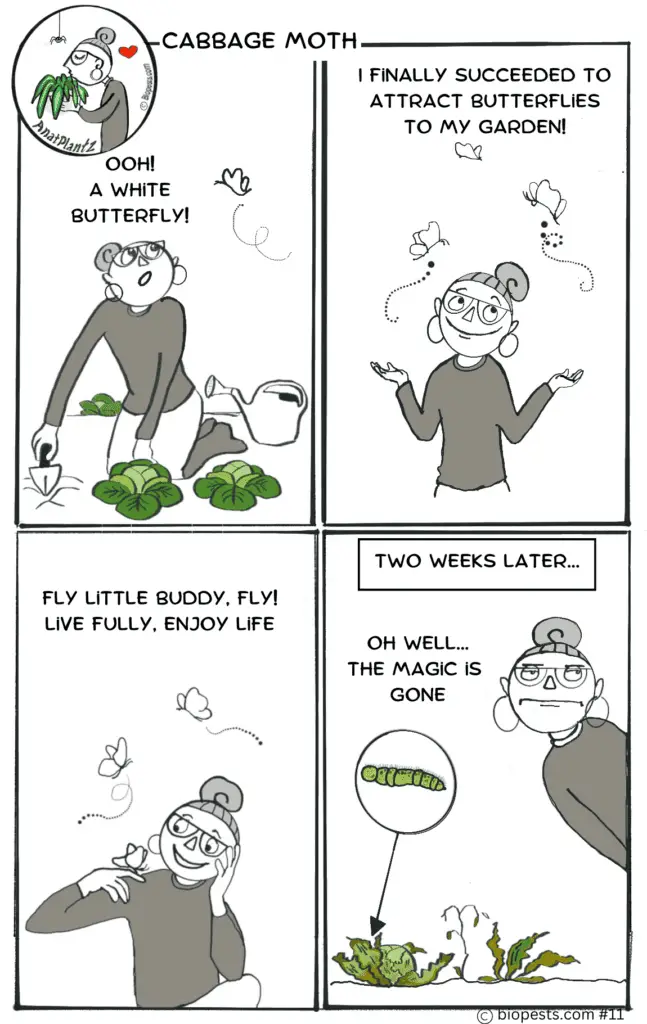
Comics by AnatPlantz
Or is it the cabbage looper?
Wait… Which one of the two?
There is often a lot of confusion between these two insects and even the most experienced gardeners mix them up sometimes not knowing how to identify them.
Needless to say, both the Cabbage Worm and the Cabbage looper are extremely dangerous for your crucifer crops and they cause extensive damage to our vegetables.
Let’s take a deeper look into these critters.
What is the difference between the cabbage worm and the cabbage looper?
Both the cabbage worm and the cabbage looper are caterpillars with similar appearances but they belong to different family species. The cabbage worm is by far more destructive than the cabbage looper.
The cabbage worm (Pieris Rapae) is the voracious larvae of the “cabbage white” butterfly. This velvety green caterpillar is 1-1/4 inch long and has faint yellow stripes on its side. It has 5 sets of pro-legs.
Cabbage worms feed mostly during the day. After feeding they rest on the undersides of the leaves, to avoid being seen by predators.
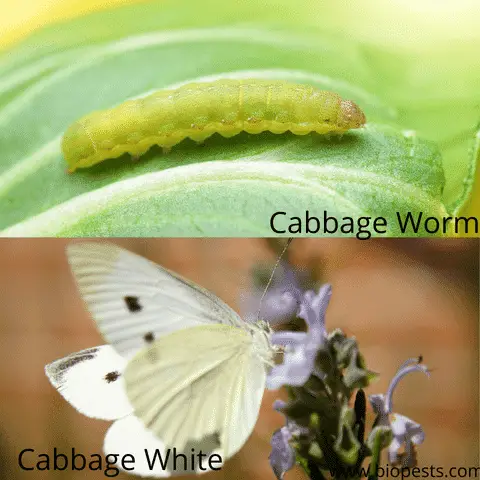
The cabbage looper (Trichoplusia ni) is the larvae of a moth commonly known as an owlet moth (a brown nocturnal moth).
This larva has 3 pairs of pro-legs and is called a looper because it arches its back into a loop when it crawls. Although the cabbage looper resembles the cabbage worm in its appearance and color, the two are not related. The cabbage looper is related to the family of cutworms and armyworms.
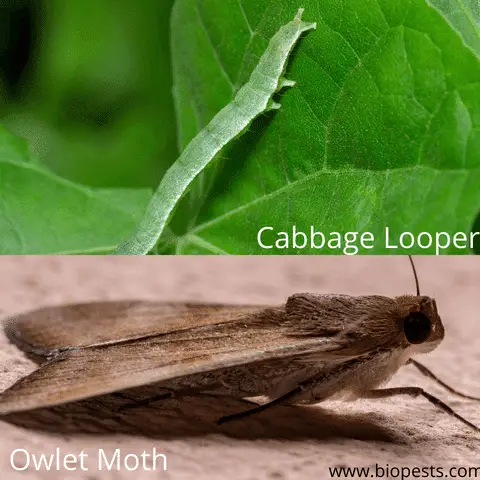
Cabbage Worm Vs Cabbage Looper: Who Is The Most Dangerous For Our Crops?
Although both the Cabbage Worm and the cabbage loopers are considered crucifer pests, the cabbage worm is considerably more dangerous than the cabbage looper.
The cabbage looper caterpillar is not always as destructive as presumed and it is considered a minor crucifer pest.
The main problem with the cabbage looper is its resistance to insecticides. The only methods of pest control are those to which it is not possible to develop resistance, and which we will see further on.
Let’s take a closer look at each one of these caterpillars separately:
The Cabbage Worm
The life cycle of cabbage worms begins around spring, when adult females of cabbage white lay their eggs on host plants, usually on the underside of leaves. After about a week, the eggs hatch and the young larvae begin to feed voraciously for about two weeks. As they grow the worm feed on the leaves and center of cabbage heads contaminating them with their fecal matter and frass.
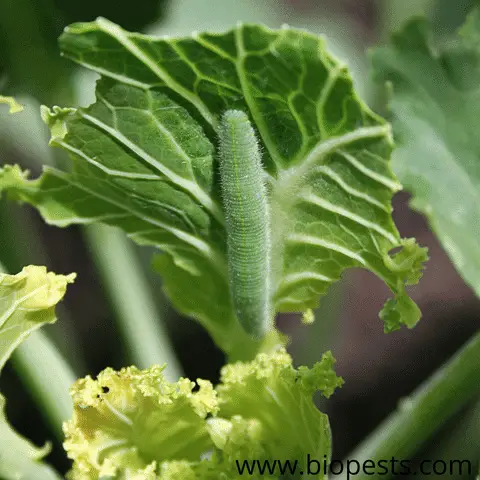
Unfortunately, if you don’t act in time, it can have catastrophic results on your cabbage crops. During this period of time, the cabbage worms are able to devour the leaves of our brassica plants reducing them into stems and veins only. After these two weeks or so, the cabbage worm pupates to become butterflies and they are no longer a threat to your garden (for the time being!). This cycle will repeat itself several times a year, depending on your climate.
The life cycle of a cabbage worm, from egg to adulthood is about three to six weeks, depending on the temperature.
Cabbage Looper
Owlet moths are most commonly found along the west coast of North America. It is such a widespread specie that in that area alone there are about 3000 known species of owlet moths!
The adult females of the owlet moth deposit their yellowish eggs on the lower surface of the leaf, and, depending on the temperature, it takes them between three to five days to hatch.
The larvae are initially pale in color, then they become green until they resemble the cabbage worm. Cabbage loopers have three pairs of prolegs and crawl arching their backs to form a loop (hence the name) then projecting the anterior section of the body forward.
The cabbage looper feeds on a wide variety of plants and weeds, not just crucifer crops, although they highly prefer the latter.
The life cycle of a cabbage looper, from egg to adulthood is about a month.
How To Prevent An Infestation Of Cabbage Worms And Loopers
The following list will work well against both the cabbage worm and the cabbage looper:
Row Covers
This is a mechanical method that works wonderfully in protecting your crops from unwanted visitations. Row covers make the top of my list because they keep away other dangerous pests such as birds, cats, and raccoons. The only drawback is that the covers won’t allow beneficial insects in. But that is something your brassica crops can live with. They are really easy to install either on the ground or on raised beds, even for beginner gardeners.
Tomato Leaf Macerate Spray
An excellent system that prevents butterflies from laying eggs on cabbage leaves is to spray a tomato leaf macerate directly on the plants. Tomato leaves act as a natural pesticide and repellent. Basically, it prevents insects from attacking the plant.
Tomatoes contain solanine, which is a toxic substance. The leaves especially are rich with it.
Tomato leaf macerate has a repellent action on moths and butterflies discouraging them to lay eggs on the leaves. It is necessary to spray the plants periodically between April and October.
The preparation of the tomato leaf macerate is quite simple: the dose to obtain an effective insecticide is about 1:1, which means 1 pound of leaves for 1 gallon of water.
It will be enough to macerate the leaves and the stems (you can use the whole tomato plant except for the fruits) and wait about five days before the mix is ready. If you want to speed up the process you can grind the vegetable parts, this way the mix can be ready to spray in just a couple of days.
Neem oil Spray
It is a non-toxic repellent. it affects insects that eat leaves both by ingestion and by contact. In addition to warding off insects, it inhibits the stimulus of insect egg-laying. You can mix your own spray or purchase it directly from Amazon here.
Soapy water Spray
It is possible to prepare the recipe at home (recipe here) and spray it directly on the leaves in the late hours of the day.
If you see that you failed to prevent the attack by the deadly caterpillars, then you might think of other biological control methods.
How to Get Rid Of Cabbage Worms And Cabbage Loopers:
There are several methods to get rid of these pesty caterpillars. Here are the most effective methods:
Bacillus thuringiensis (BT)
This insecticide is a bacteria that is found naturally in soil. BT produces spores that are toxic to certain types of insects. This is very effective and above all safe for humans and for other beneficial insects and pollinators (it is a very selective insecticide).
When using Bacillus Thuringiensis make sure that you apply the product when the caterpillars are at an early stage of development. This product makes them stop eating till they starve to death. The larvae will day within one to five days (knowing their life cycle, and the timing for the application of BT is vital).
Spray in the late afternoon or early evening, when the caterpillars are actively feeding and the product won’t be affected by the sun.
Parasitoid Wasps
These tiny, tiny wasps are barely visible by the naked eye and are a powerful biological pest control method. They are not dangerous as they do not sting humans. They lay their eggs on the host insects (in this case the caterpillar) so that their larvae feed on them once they hatch the eggs. You can read more on Parasitoid Wasp here.
Food Grade Diatomaceous earth
I have already written in numerous other articles about how effective is the use of food-grade Diatomaceous earth as pest control. This product comes in the form of white-greyish powder and the application is quite easy: you simply sprinkle the product directly on the plant. It kills insects on contact, dehydrating them to death (this process might take up to 24 hours). You can read more on DE here. The positive aspect of this product is that it is safe for humans and insects cannot develop a resistance to it. The drawback is that being an indiscriminate method of pest control, it kills also pollinators and other beneficial insects, with no distinction.
Hand Picking
I kept this option at the bottom of my list and it is only for those who feel comfortable personally picking and handling these caterpillars. Needless to say, this option is relevant only to those who own a small vegetable garden, since it is time-consuming. If the caterpillars are hiding inside the brassica, the fastest way to spot them is to look for their frass (their fecal matter).
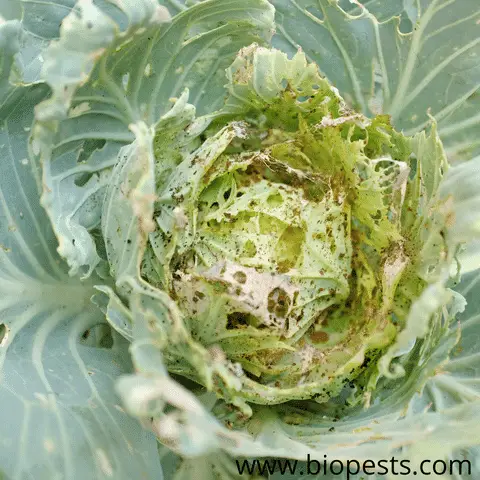
It can be a fun activity to do with children. The worms can be a great snack for chickens if you have them!
Conclusion
although the presence of butterflies in our gardens is pleasant and apparently harmless, sometimes these insects hide real dangers that can lead to the destruction of our crops! Let’s not get caught unprepared! Keep monitoring your garden constantly and remember that prevention is always better than cure!
Some of the links above are affiliate links, meaning, at no additional cost to you, I will earn a commission if you click through and make a purchase.

